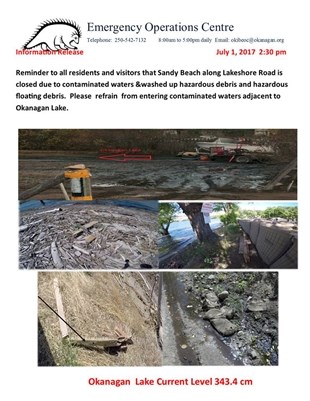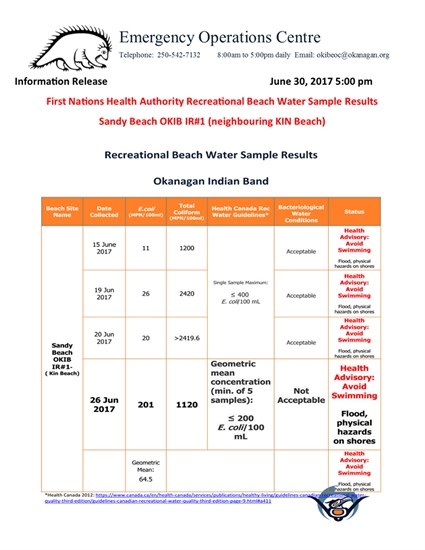
FILE PHOTO: A sign posted at Sandy Beach on June 2, 2017. As of July 7, 2017, the water is still considered contaminated.
(CHARLOTTE HELSTON / iNFOnews.ca)
July 09, 2017 - 7:30 PM
VERNON - If you go down to Sandy Beach on Okanagan Lake, you’ll find signs that state: “Danger: Contaminated Water.” But, if you walk just a little further to the adjacent Kin Beach, you’re good to go, according to the regional district and Interior Health.
The discrepancy has at least one Vernon politician scratching her head.
“It’s confusing for the public and I can see why,” Greater Vernon Advisory Council chair Juliette Cunningham says.
She says Greater Vernon sends samples to a private lab on a weekly basis, which then get passed on to the Interior Health Authority for review. Interior Health posts the results online, and if there are any concerns, they notify the regional district.
“To this point, all the testing that has been done is coming back within the guidelines,” Cunningham says.
While Kin Beach is operated by the regional district, Sandy Beach is on Okanagan Indian Band land and all water testing is done by the First Nations Health Authority. In recent weeks, the band has issued several notices warning of contaminated water at the north end of Okanagan Lake, and at Sandy Beach specifically.

Information bulletin issued by the Okanagan Indian Band
Image Credit: Okanagan Indian Band
On June 26, the First Nations Health Authority reported unacceptable levels of E. coli at Sandy Beach. Levels posted online by Interior Health from the same date show sampling from three sections of Kin Beach all coming back within acceptable levels.
The First Nations Health Authority tells iNFOnews.ca that it uses the same methodology and guidelines as Interior Health when determining water quality. The discrepancy in results, it says, can be attributed to a variety of factors.
“There are many reasons why there could be differences from the results posted by IHA,” the health authority said by email. “Proximity to sources of contamination (e.g. Vernon Creek, birds, dogs, etc), wind conditions, mixing of water, etc.”
With respect to the location of the beach sampling, the First Nations Health Authority says water was collected on Sandy Beach specifically, in water about 18” deep. Samples are 100 ml — about a third of a pop can.
“When you consider what that volume is compared to the entire beach area being monitored, it's easy to see why ongoing sampling and averaging is important to get a reliable sense of water quality,” First Nations Health states.
Results are averaged over five samples, and it’s not unusual to have individual samples that are significantly higher or lower than the average when comparing the same site between different times, or slightly different locations at the same time, according to First Nations Health.
Follow up questions regarding specific test results at Sandy Beach and the corresponding swimming advisory were not made available prior to publication.
According to the Interior Health Authority, it's best to always play it safe when swimming in local lakes.
“While there is heightened attention and monitoring of water due to the recent flood situation, the public should be aware there is always a risk when it comes to potential contaminants in recreational water. The public is encouraged not to swim in areas near septic systems which may have been compromised. Bodies of water are always flowing and changing, so the public is advised to exercise caution, and check sampling results regularly,” Interior Health says in a written statement.

Water test results from the First Nations Health Authority for June 26, 2017.
Image Credit: Okanagan Indian Band

Water quality results posted online by Interior Health for June 26, 2017 for Kin Beach, which is directly beside Sandy Beach.
Image Credit: Interior Health Authority
To contact a reporter for this story, email Charlotte Helston or call 250-309-5230 or email the editor. You can also submit photos, videos or news tips to the newsroom and be entered to win a monthly prize draw.
?We welcome your comments and opinions on our stories but play nice. We won't censor or delete comments unless they contain off-topic statements or links, unnecessary vulgarity, false facts, spam or obviously fake profiles. If you have any concerns about what you see in comments, email the editor in the link above.
News from © iNFOnews, 2017